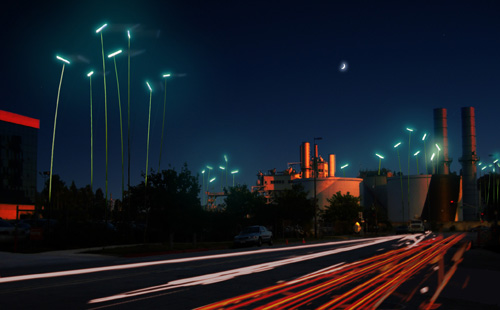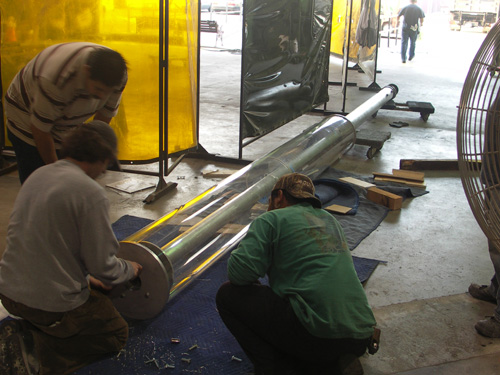realities:united (realU) and UeBERSEE
Description of POWERPLANTS from realU website:
KINETIC LIGHT SCULPTURES AS A CATALYST FOR AND SYMBOL OF THE TRANSFORMATION OF A POST-INDUSTRIAL URBAN DEVELOPMENT AREA
Powerplants is a land art project for the site of a former power plant in Pasadena, which is being redeveloped as a new expansion for the Pasadena Arts Center, as well as for a planned development park consisting of high-tech businesses and offices. This transformation from an old power plant to what has been named the “Glenarm Innovation Corridor” was in need of an artistic strategy to visually accompany and support the ongoing urban (re-)development over the years to come.A singular symbol in just one location quickly revealed itself to be an unfeasible solution here: the grounds are expansive and very eclectic due to their heterogeneous construction. Not so expansive was the low budget for “public art”, which the city set aside for the project’s development. That’s why a modular concept was developed, which could be extended at any time through additional private investments in connection with expected business settlements moving into the Innovation Corridor, thereby adopting and strengthening the area’s artistic (and professional) aura.
The proposal is a conceptual strategy superimposing new, modular and interconnected structures on the remains of old industry. The structures bridge the gap between industry, nature and information technology. They are a new breed of Powerplants, with slender stalks reaching about 55 feet into the sky, the same height as the famed palm trees of Southern California. Each topped by a cylindrical light tube, they emit soft and pulsating light signals powered by solar energy stored during the day. The metal structure is reminiscent of the site’s industrial history and allows movement via light breezes, swaying gently in the wind like the palm trees. It is, however, strong enough to withstand storms and earthquakes.
Because of their sculptural qualities, Powerplants are effective as single objects as well as in small or large groups. Connected via a wireless communication network, they are programmed to exchange light impulses with each other, create abstract light configurations or glow in unison. Because they are physically independent from each other and electrically self-sustainable, there is no need for wiring, thereby making it possible to “plant” and “replant” them in any given sequence and arrangement. They can therefore react flexibly to the area’s development, which is set to occur over the next two decades. They can expand, reproduce, or retract piece by piece, or be concentrated in one area. After successfully constructing a prototype Powerplants was put on hold for administrative reasons. The future is uncertain…
PROJECT COLLABORATION
Project Partnership
Prof. Nick Hafermaas / Art Center College of Design
Advising Engineers Phase One
OSD office for structural design
Advising Engineers Phase Two
Schlaich Bergermann und Partner Structural Consulting Engineers
PROJECT MANAGEMENT (REALU)
Christoph Wagner
Jan Edler
PROJECT TEAM (REALU)
Malte Niedringhaus
Marie Banâtre
Robert Ostmann



